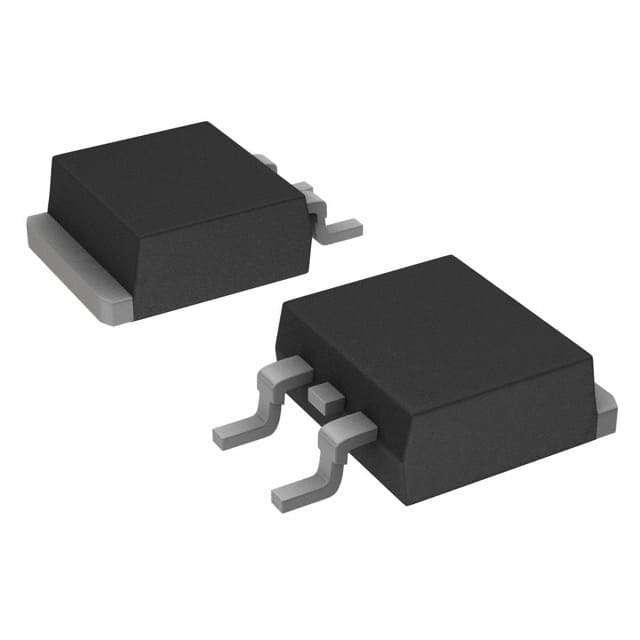Xem thông số kỹ thuật để biết chi tiết sản phẩm.

SBLB10L30HE3/81
Product Overview
Category
The SBLB10L30HE3/81 belongs to the category of Schottky Barrier Rectifiers.
Use
It is commonly used in electronic circuits for rectification and voltage regulation.
Characteristics
- Low forward voltage drop
- High current capability
- Fast switching speed
- High temperature operation
Package
The SBLB10L30HE3/81 is typically available in a surface-mount package.
Essence
This product is essential for efficient power management in various electronic devices and systems.
Packaging/Quantity
It is usually packaged in reels or tubes, with quantities varying based on manufacturer specifications.
Specifications
- Maximum Average Forward Current: 10A
- Peak Forward Surge Current: 150A
- Reverse Voltage: 30V
- Operating Temperature Range: -65°C to +175°C
- Package Type: D2PAK
Detailed Pin Configuration
The SBLB10L30HE3/81 has a standard D2PAK pin configuration with three pins: Anode, Cathode, and Gate.
Functional Features
- Low forward voltage drop ensures minimal power loss
- Fast switching speed allows for efficient regulation
- High current capability supports diverse application requirements
Advantages
- Enhanced energy efficiency
- Compact form factor
- Suitable for high-frequency applications
Disadvantages
- Limited reverse voltage tolerance
- Sensitivity to overvoltage conditions
Working Principles
The SBLB10L30HE3/81 operates based on the Schottky barrier principle, where the metal-semiconductor junction enables low forward voltage drop and fast switching characteristics.
Detailed Application Field Plans
Power Supplies
The SBLB10L30HE3/81 can be utilized in power supply units for consumer electronics, industrial equipment, and automotive systems.
Voltage Regulation
It is suitable for use in voltage regulator modules and DC-DC converters for efficient power management.
Solar Energy Systems
In solar inverters and charge controllers, this rectifier aids in converting and regulating solar energy efficiently.
Detailed and Complete Alternative Models
- SBLB20L40HE3/81
- SBLB15L25HE3/81
- SBLB12L20HE3/81
These alternative models offer similar performance characteristics and are compatible with the same application scenarios.
This entry provides comprehensive information about the SBLB10L30HE3/81, covering its category, use, characteristics, specifications, pin configuration, functional features, advantages, disadvantages, working principles, application field plans, and alternative models.
Liệt kê 10 câu hỏi và câu trả lời thường gặp liên quan đến ứng dụng SBLB10L30HE3/81 trong giải pháp kỹ thuật
What is the SBLB10L30HE3/81 used for in technical solutions?
- The SBLB10L30HE3/81 is a Schottky diode designed for high efficiency and low forward voltage drop, making it suitable for various technical solutions requiring fast switching and low power loss.
What are the key specifications of the SBLB10L30HE3/81?
- The SBLB10L30HE3/81 has a maximum average forward current of 10A, a reverse voltage of 30V, and a low forward voltage drop, making it ideal for applications where power efficiency is crucial.
In what types of circuits can the SBLB10L30HE3/81 be used?
- The SBLB10L30HE3/81 can be used in rectifier, freewheeling, and polarity protection circuits due to its low forward voltage drop and fast switching characteristics.
What are the typical applications of the SBLB10L30HE3/81 in technical solutions?
- Typical applications include power supplies, LED lighting, motor drive circuits, and battery charging systems where high efficiency and low power loss are essential.
How does the SBLB10L30HE3/81 contribute to energy efficiency in technical solutions?
- The SBLB10L30HE3/81's low forward voltage drop minimizes power dissipation, leading to improved energy efficiency in various electronic systems.
What are the temperature considerations for using the SBLB10L30HE3/81 in technical solutions?
- The SBLB10L30HE3/81 is designed to operate over a wide temperature range, making it suitable for applications that require reliable performance in varying thermal conditions.
Can the SBLB10L30HE3/81 handle high-frequency switching?
- Yes, the SBLB10L30HE3/81 is capable of handling high-frequency switching due to its fast recovery time and low junction capacitance.
Are there any recommended layout or mounting considerations for the SBLB10L30HE3/81?
- It is recommended to minimize the length of the PCB traces connected to the diode to reduce parasitic inductance and ensure optimal performance.
What are the potential benefits of using the SBLB10L30HE3/81 in technical solutions compared to other diodes?
- The SBLB10L30HE3/81 offers lower forward voltage drop, faster switching speed, and higher efficiency, making it a preferred choice for applications requiring these characteristics.
Where can I find detailed application notes and design guidelines for integrating the SBLB10L30HE3/81 into technical solutions?
- Detailed application notes and design guidelines can be found in the product datasheet, as well as on the manufacturer's website, providing comprehensive information for successful integration of the diode into various technical solutions.

